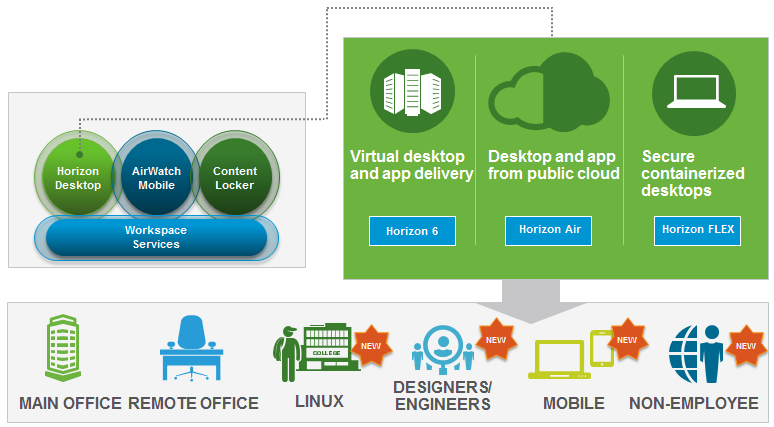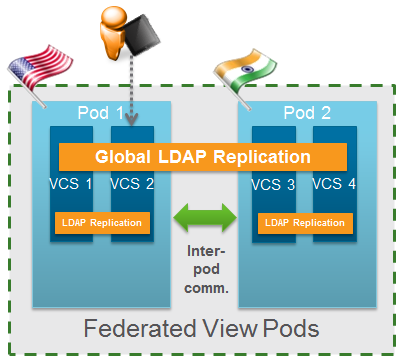This post is also available in: Italian
Reading Time: 5 minutesEnd User Computing (EUC) scenario has change in the last year… not one single killer application for all cases, but multiple Technologies for different user cases or customers needs. Does not make sense say that this could be the year of VDI… VDI is growing but will never been a killer application… just one solution with its market segment.
But there are also Apps and RemoteApps, DaaS, FLEX, Mobile, Managed desktop/laptop, and lot of other solutions!
VMware still consider the EUC a main pillar, but its proposition has been modified to cover the new scenarios. VMware Horizon is now a Desktop transformation solution for every user.
Note that the Horizon Desktop has changed some names: Horizon 6 (formally Horizon with View) is for VDI, Horizon Air is for the DaaS solution and Horizon FLEX (powerd by VMware Mirage) is for the BOYD case.
Less than an year ago, VMware announce the new version of Horizon with View 6.0 with the new remote apps support, now they are announcing a new 6.1 version with new major features additions:
- Apps: for Hosted Applications and RDS Desktops. Version 6.0.1 has already added the Printing function, now 6.1 will add scanning & imaging, smart card, USB mass storage support.
With the USB mass storage support will be possible enable port-level redirection of local USB storage devices to be used with Hosted Desktops and Apps, but note that will be limited to RDSH Servers running Windows 2012 and 2012 R2 and will be supported only with Windows clients.
Technical Preview also will add HTML access (Blast protocol) and drive redirection in order to redirects local folders and drives to be used with Hosted Desktops and Apps, but will be supported only with Windows clients initially (in the future will expand to cover Mac and Linux) - Rich Graphics: to support Multiple Graphics Workstations & Applications with NVIDIA GRID and enable shared access to physical GPUs on NVIDIA GRID GPU hardware for 3D and high performance compute workloads thought the native NVIDIA drivers in Windows (but also with a NVIDIA VIB installed on ESX to manage GPU).
- Storage: will be simplified and optimized by adding support for Virtual Volumes (VVOL) for Horizon 6 Desktops and also improve the existing VSAN support to the new VSAN 6.0 version and increase the scaling capabilties:
- From 100 to 200 desktops per host
- From 1600 to 4000 desktops per VSAN cluster
- From 16 to 20 hosts per VSAN cluster
- Virtual Networking: NSX brings the simplicity, programmability and adaptability of virtualization, to networking and security for virtual desktops, saving time, complexity and reducing error.
Also IPv6 support has been added in order to enable customer adoption and transition to IPv6 addressing conventions.
For the architecture and design aspects, there are some interesting changing the Pod model, especially when multiple sites are used: there is a new cloud Pod architecture with federation across Pods.
The new multisite model will enable View deployments across multiple datacenters and multiple sites with replication of data. It’s not yet clear if will be used the new vCenter architecture (so only available with vSphere 6.0) or something similar, but independent.
Also there are a lot of interesting news about the supported OSes…
From the client point of view the list of supported OSes was already complete (Windows, Mac, Linux, iOS and Android), but now will be added also the Chromebook support (actually only in a technical preview) in order to provide unlimited access also for Remote Apps to this popular low cost Platform.
Actually Chromebooks are popular in verticals market like Education but also making inroads into Enterprises. The pros of those device are the low cost, low maintenance, stateless, but the big challenge is achieving a good user experience. The technical preview of the Chromebook client (available on Q1/Q2 2015) will be based on popular Horizon Client for Android.
On the virtual desktop point of view there are some interesting announcements:
- Windows Server 2012 R2 Desktop Support: in order to use Windows Server 2012 R2 as a desktop OS in Horizon 6 (Windows Server 2012 R2 was already supported in the infrastructure side) and enable this usage scenario both Public and Private cloud and deployments
- Linux Desktops (only in technical preview): first step to introducing support for Linux Virtual Desktop in VMware Horizon, by supporting popular Linux distributions (including Ubuntu, RHEL). The technical preview program will start probably at the end of March
From my point of view the much interesting takeaway from those announces are:
- The major focus on the remote application model that can well fit in cases where standardization is massive and requirements are mostly simple and limited to few applications.
- The increased OS support in virtual desktop with the big news of a first step of Linux support (actually there are really few VDI solution that support Linux desktop)… but could be nice see which features will be available on them (like PCoIP, Blast, remote printing, device redirection….).
- The growing in Blast protocol capabilities (the same that is used in VMware HoL)… will be nice see if in the features it will become the main protocol for remote app or desktop (at least for the Horizon product).
The new release of VMware Horizon 6.1 is generally available on the download site.





